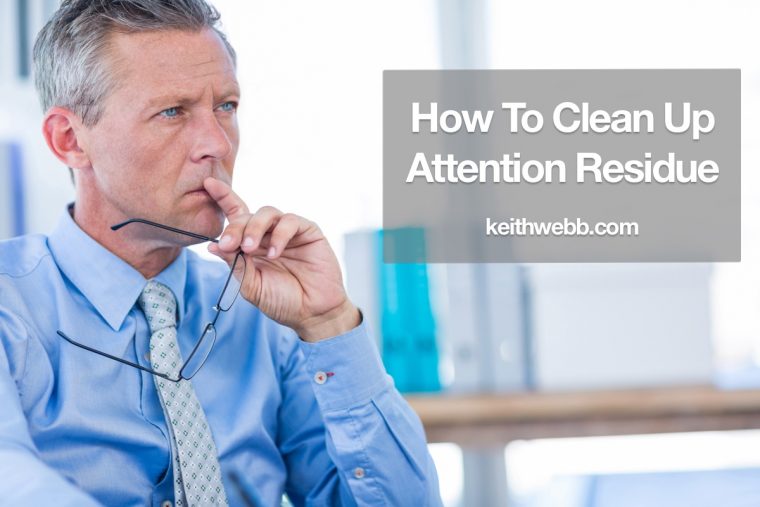When you check your email, read your messages, answer the phone, or have a quick conversation, your attention stays with that task even after you’ve moved onto the next. For a period of time, you’re unable to give the next task your full attention. This phenomena has been called “attention residue” and it’s hurting your thinking. Here’s how to clean up attention residue to get your focus back.

I’ve noticed how I can’t jump from answering emails to doing thinking work. My mind stays with the emails. I replay the email and my response in my head. Or I start thinking about or planning the work that email triggered. The more emotional my response to the email, the longer my mind stays with it.
Business professor Sophie Leroy from the University of Minnesota identified this as attention residue. I first read about it in the excellent book, Deep Work (p. 41).
In the workshops I regularly lead, I can see participants having trouble reengaging after a break where they took a call or responded to emails and messages. While those who grabbed a coffee and chatted with another participant don’t have the same struggle.
I’ve written elsewhere that multitasking is a myth. Multitasking is a euphemism for distracted working. It takes mental focus to do our best work.
Attention residue is another of the devastating effects that multitasking has on your productivity.
Controlling Attention Residue
The best way to clean up attention residue is to not create it in the first place.
Emails. A Microsoft study showed 23% of distractions at work come from email. Even hearing the “ping” of a new email without reading it, distracts our attention. Quit your email program and set notifications to Off – on your computer, phone, tablet – on every device. Successful leaders choose when to read and respond to emails.
Social media. Is there a greater distraction machine? Social media leaves behind heavy attention residue you may not even be aware of. Irritation over a political comment. Jealousy of someone else. Fear of falling behind. Thoughts of weekend plans. Quit your social media programs and set notifications to Off.
Calls & Appointments. The topic of the conversation, what-ifs, next steps, and relational dynamics all leave behind attention residue. I try to batch all my calls and appointments to Mondays and Fridays. My phone (Skype, Zoom, etc.) is off while I’m working on the other days. If someone needs to contact me they’ll email, text, or leave a voicemail and I’ll get back to them.
Doing these things takes mental discipline. Like Pavlov’s dog, we’ve been conditioned to respond to the “pings” to see who “likes” us. You can’t pay the bills with “likes.”
Clean Up Residue With Physical Movement
Despite our best efforts attention residue will creep in. What do we do? I’ve found physical movement to be the easiest way to clean up attention residue.
Stand up. Your mind reacts to movement. Even standing up will clear your thoughts. The more emotion you have in the previous task, the more movement you need.
Walk. Walking has been shown to clear one’s mind, focus thinking, and increase creativity. “Walking solves it,” St. Augustine wrote. When I write articles, I need to think deeply and focus. Coaching conversations or answering emails leave a lot of attention residue. So, I can’t jump straight into writing. I use walking to clean up this kind of sticky attention residue. First, I prepare my desk and computer for writing by removing other distracting work and closing programs. Then, I go outside and walk. Across the street to the mailbox works. Around the block is even better. When I return, I sit down and immediately begin writing.
Move. In our workshops, participants practice coaching conversations in pairs. After 15 minutes, we ask them to switch roles so the person who was coached can practice being the coach. What often happens, however, is they don’t switch roles, but continue with the previous conversation. The easy solution, I found, is to ask them to stand up and switch seats. When they do so, they also switch roles.
These examples show how physical movement cleans up attention residue. The key is to move without adding new attention. For example, if you go get a cup of coffee and along the way have a conversation with a colleague, that conversation may leave some attention residue.
Question: How do you clean up attention residue? You can leave a comment by clicking here.


I look out the window for a few minutes noticing the sky, shadows, birds, etc. to stay present in the moment and clear my mind of clutter.